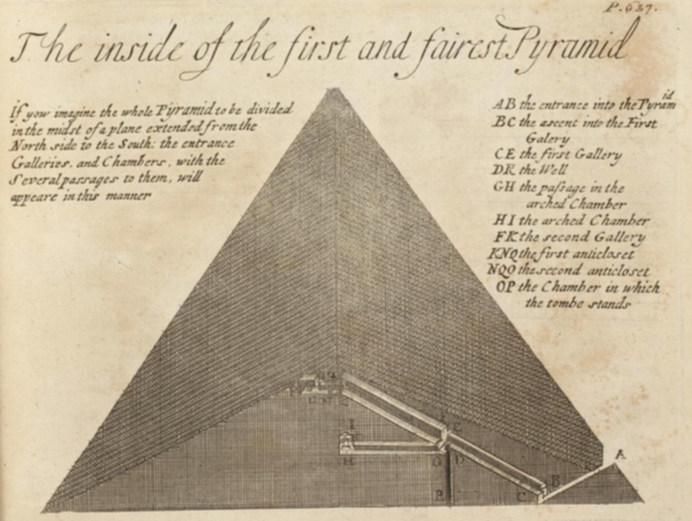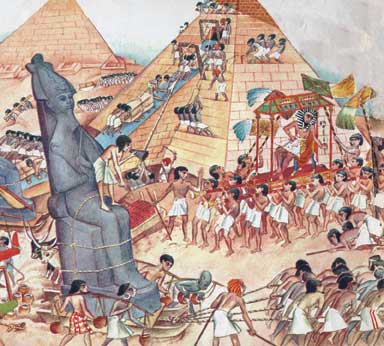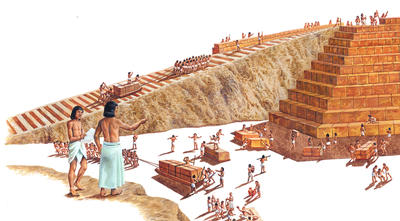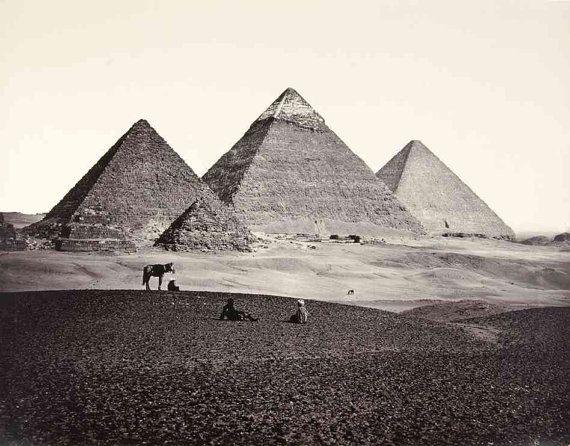The Man Who Built the First Pyramid is a title often attributed to Imhotep, the ancient Egyptian polymath whose ingenuity and vision transformed the landscape of human achievement. As the architect of the Step Pyramid of Djoser, Imhotep not only revolutionized construction techniques but also embodied the multifaceted genius of early civilization. This article explores his life, innovations, and enduring influence, shedding light on a figure who bridged the gap between mortality and myth, leaving an indelible mark on history.
The Enigmatic Figure: Imhotep’s Life and Times

Imhotep’s existence is a testament to the challenges of uncovering ancient histories, where fact often intertwines with legend. As one of the earliest named individuals in recorded history, he emerges from the shadows of the Third Dynasty of Egypt, a period marked by significant advancements in art, architecture, and governance. His story is pieced together from sparse inscriptions, artifacts, and later deifications, making him a figure of enduring fascination. This section delves into the man behind the myth, exploring how a commoner rose to become a pivotal figure in Egyptian society, influencing not just architecture but also medicine, administration, and religion.
Early Historical Records

Historical records of Imhotep are fragmented, relying heavily on inscriptions from later periods, such as those found in the Turin King List and various stelae. Born around 2650 BCE during the reign of Pharaoh Djoser, Imhotep is first mentioned in connection with the construction of the Step Pyramid at Saqqara. These early accounts portray him not merely as a builder but as a high-ranking official, holding titles that suggest a broad skill set. For instance, he was referred to as the “Chancellor of the King of Lower Egypt” and “Administrator of the Great Palace,” indicating his involvement in both civil and royal affairs.
What makes Imhotep’s early life intriguing is the lack of personal details, which fuels speculation about his origins. Some scholars believe he may have come from a family of artisans or priests, given the specialized knowledge required for his achievements. This anonymity adds to his enigmatic aura, as he is one of the few non-royal figures from ancient Egypt to be commemorated in writing. Despite the scarcity of direct evidence, his inclusion in texts like the Palermo Stone highlights his importance, showing that even in his time, he was recognized as a key innovator. This recognition underscores how Imhotep’s contributions were not isolated events but part of a larger cultural shift toward monumental architecture and centralized power.
Another aspect of early records is the way Imhotep’s name appears in medical papyri, such as the Edwin Smith Papyrus, which dates to around 1600 BCE but is believed to draw from earlier sources. This document credits him with advancements in surgical techniques and herbal remedies, suggesting that his influence extendedto various fields beyond architecture, laying the groundwork for future medical practices. The reverence for Imhotep in later texts showcases not only the legacy of his accomplishments but also the cultural significance attached to his name, as he became synonymous with wisdom and healing.
Architectural Mastery: The Step Pyramid

The monumental achievement that catapulted Imhotep into the annals of history is, of course, the Step Pyramid of Djoser, a revolutionary structure that marked the beginning of large-scale stone construction in Egypt. This pyramid, built around 2630 BCE at Saqqara, signified a radical departure from the traditional burial mounds known as mastabas, showcasing Imhotep’s innovative vision and architectural prowess.
The Step Pyramid comprises six tiers, rising to a height of approximately 62 meters, making it the world’s first monumental stone building. What sets this structure apart is not merely its size but the ingenuity behind its design and the techniques employed during construction. Imhotep’s use of dressed limestone blocks instead of mud bricks allowed for greater durability and aesthetic appeal. This approach would eventually become the hallmark of Egyptian architecture.
Imhotep’s architectural mastery can be further appreciated through the intricate layout of the Step Pyramid complex, which included temples, courtyards, and ceremonial areas designed for ritual practices. This holistic design reflects a sophisticated understanding of spatial organization and religious symbolism, marking a significant evolution in how funerary sites were conceived in ancient Egypt. The alignment of the pyramid with cardinal points also indicates the spiritual and astronomical knowledge possessed by Imhotep, who intricately wove together material and metaphysical dimensions.
Notably, the Step Pyramid paved the way for subsequent pyramids, including the more famed true pyramids built during the Fourth Dynasty, such as those at Giza. Imhotep’s influence on architecture continues to resonate today, as modern architects study his techniques to inspire current innovations. His unique ability to blend functionality with grand aesthetics represents a cornerstone of architectural thought, illustrating that even in ancient times, the pursuit of beauty and utility was paramount.
Contributions to Medicine

While Imhotep is widely celebrated for his architectural feats, his contributions to medicine are equally noteworthy and often overshadowed in discussions about his legacy. As one of the earliest recorded physicians in history, Imhotep played a pivotal role in shaping ancient Egyptian medicine, integrating practical knowledge with mystical beliefs prevalent during his time.
The Edwin Smith Papyrus, which outlines surgical procedures and anatomical observations, serves as a testament to Imhotep’s medical expertise. It reveals insights into trauma care and surgical techniques, demonstrating a surprisingly advanced understanding of human anatomy. The papyrus details methods for treating wounds, fractures, and dislocations, indicating that Imhotep’s approach to medicine combined empirical observation with a systematic methodology, setting a precedent for future medical practices.
In addition to surgery, Imhotep’s reputed knowledge of herbal remedies contributed to the practice of pharmacology in ancient Egypt. He is associated with a myriad of medicinal plants and their therapeutic applications, suggesting that he recognized the importance of natural remedies in healing. This perspective reflects a holistic view of health that resonates with contemporary approaches in alternative medicine, where the integration of nature and science is increasingly valued.
Imhotep’s status as a deity of medicine in later Egyptian mythology further underscores his enduring influence. Revered as a god of healing and wisdom, his name became synonymous with medical knowledge, and he was often invoked in prayers for health and recovery. This transformation from a historical figure to a divine entity illustrates the profound impact Imhotep had not just on his contemporaries but on generations who followed, solidifying his place as a foundational figure in both architecture and medicine.
Lasting Influence and Legacy

The legacy of Imhotep extends far beyond the boundaries of ancient Egypt, echoing through the corridors of history and influencing numerous cultures and disciplines. His innovations in architecture, medicine, and governance have inspired countless generations, underscoring the timelessness of his contributions.
One of Imhotep’s most significant legacies lies in the architectural realm, where his pioneering designs laid the groundwork for future civilizations. The principles of construction and design he introduced found resonance in Greek, Roman, and even modern architecture, as they built upon the conceptual frameworks established by Imhotep. His emphasis on monumental structures influenced how societies perceive power and authority, demonstrating that architecture can serve as a reflection of cultural values.
In the field of medicine, Imhotep’s methodologies and teachings shaped the foundations of medical practice in Egypt and beyond. His work was revered by later scholars, and his concepts were integrated into the work of Hippocrates and Galen, forming a bridge between ancient wisdom and emerging medical traditions in the West. The reverence for Imhotep in both medical and philosophical contexts highlights his role as a pioneer of rational thought and inquiry at a time when many aspects of life were still steeped in mysticism.
Additionally, Imhotep’s transition from a historical figure to an object of worship signifies the power of cultural narratives in shaping collective memory. His deification reflects the need for societies to anchor their values and aspirations in figures who embody wisdom and creativity. The mythologization of Imhotep speaks to a universal human desire to honor those who push the boundaries of knowledge and achievement, creating aspirational models for future generations.
Conclusion

The story of Imhotep is one of ingenuity, resilience, and transformation—a narrative that transcends the confines of time and space. As the architect of the Step Pyramid and a pioneer in medicine, Imhotep’s legacy is woven into the very fabric of human achievement. His life and work serve as a reminder of the potential that individuals possess to shape their worlds through innovation and creativity.
From the sands of ancient Egypt to the halls of modern academia, Imhotep’s influence continues to inspire architects, physicians, and thinkers alike. His journey from a commoner to a symbol of wisdom encapsulates the essence of human aspiration, urging us all to strive for greatness in our endeavors. As we reflect on Imhotep’s revolutionary legacy, we are reminded that the spirit of innovation knows no bounds, inspiring us to explore new frontiers in our quest for knowledge and understanding.

GIPHY App Key not set. Please check settings